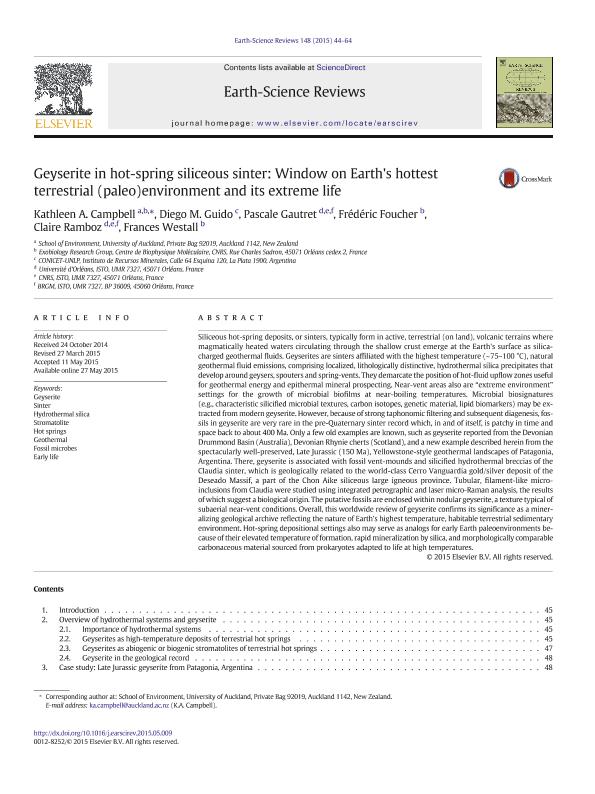Artículo
Geyserite in hot-spring siliceous sinter: window on Earth's hottest terrestrial (paleo)environment and its extreme life
Campbell, Kathleen A.; Guido, Diego Martin ; Gautret, Pascale; Foucher, Frédéric; Ramboz, Claire; Westall, Frances
; Gautret, Pascale; Foucher, Frédéric; Ramboz, Claire; Westall, Frances
 ; Gautret, Pascale; Foucher, Frédéric; Ramboz, Claire; Westall, Frances
; Gautret, Pascale; Foucher, Frédéric; Ramboz, Claire; Westall, Frances
Fecha de publicación:
09/2015
Editorial:
Elsevier Science
Revista:
Earth-science Reviews
ISSN:
0012-8252
Idioma:
Inglés
Tipo de recurso:
Artículo publicado
Clasificación temática:
Resumen
Siliceous hot-spring deposits, or sinters, typically form in active, terrestrial (on land), volcanic terrains where magmatically heated waters circulating through the shallow crust emerge at the Earth's surface as silica-charged geothermal fluids. Geyserites are sinters affiliated with the highest temperature (~ 75–100 °C), natural geothermal fluid emissions, comprising localized, lithologically distinctive, hydrothermal silica precipitates that develop around geysers, spouters and spring-vents. They demarcate the position of hot-fluid upflow zones useful for geothermal energy and epithermal mineral prospecting. Near-vent areas also are “extreme environment” settings for the growth of microbial biofilms at near-boiling temperatures. Microbial biosignatures (e.g., characteristic silicified microbial textures, carbon isotopes, genetic material, lipid biomarkers) may be extracted from modern geyserite. However, because of strong taphonomic filtering and subsequent diagenesis, fossils in geyserite are very rare in the pre-Quaternary sinter record which, in and of itself, is patchy in time and space back to about 400 Ma. Only a few old examples are known, such as geyserite reported from the Devonian Drummond Basin (Australia), Devonian Rhynie cherts (Scotland), and a new example described herein from the spectacularly well-preserved, Late Jurassic (150 Ma), Yellowstone-style geothermal landscapes of Patagonia, Argentina. There, geyserite is associated with fossil vent-mounds and silicified hydrothermal breccias of the Claudia sinter, which is geologically related to the world-class Cerro Vanguardia gold/silver deposit of the Deseado Massif, a part of the Chon Aike siliceous large igneous province. Tubular, filament-like micro-inclusions from Claudia were studied using integrated petrographic and laser micro-Raman analysis, the results of which suggest a biological origin. The putative fossils are enclosed within nodular geyserite, a texture typical of subaerial near-vent conditions. Overall, this worldwide review of geyserite confirms its significance as a mineralizing geological archive reflecting the nature of Earth's highest temperature, habitable terrestrial sedimentary environment. Hot-spring depositional settings also may serve as analogs for early Earth paleoenvironments because of their elevated temperature of formation, rapid mineralization by silica, and morphologically comparable carbonaceous material sourced from prokaryotes adapted to life at high temperatures.
Archivos asociados
Licencia
Identificadores
Colecciones
Articulos(CCT - LA PLATA)
Articulos de CTRO.CIENTIFICO TECNOL.CONICET - LA PLATA
Articulos de CTRO.CIENTIFICO TECNOL.CONICET - LA PLATA
Citación
Campbell, Kathleen A.; Guido, Diego Martin; Gautret, Pascale; Foucher, Frédéric; Ramboz, Claire; et al.; Geyserite in hot-spring siliceous sinter: window on Earth's hottest terrestrial (paleo)environment and its extreme life; Elsevier Science; Earth-science Reviews; 148; 9-2015; 44-64
Compartir
Altmétricas



